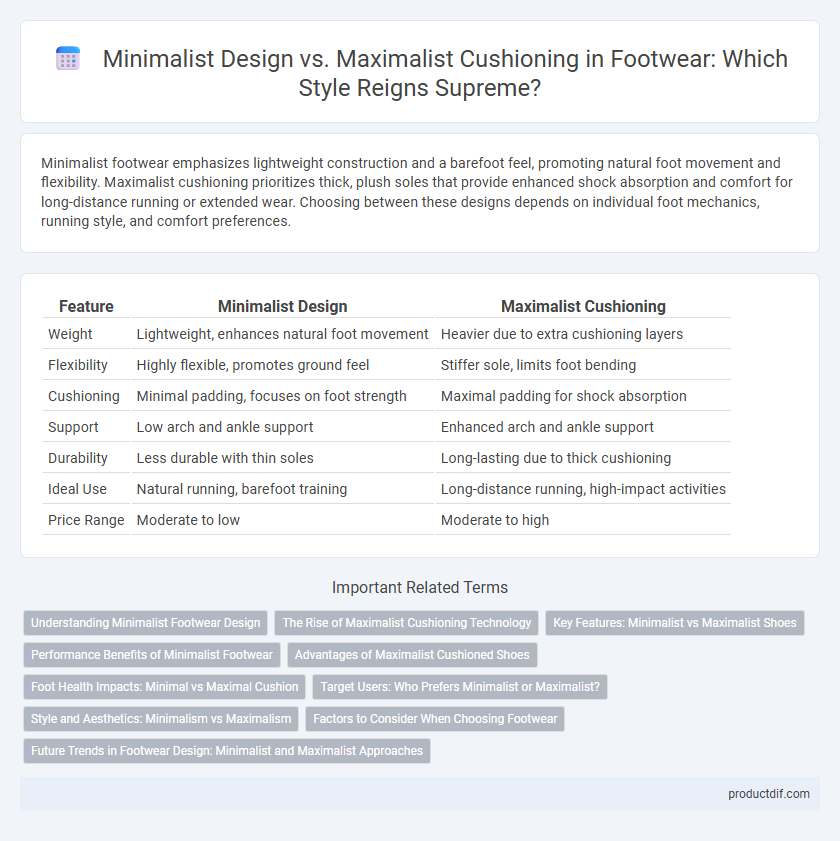Minimalist footwear emphasizes lightweight construction and a barefoot feel, promoting natural foot movement and flexibility. Maximalist cushioning prioritizes thick, plush soles that provide enhanced shock absorption and comfort for long-distance running or extended wear. Choosing between these designs depends on individual foot mechanics, running style, and comfort preferences.
Table of Comparison
| Feature | Minimalist Design | Maximalist Cushioning |
|---|---|---|
| Weight | Lightweight, enhances natural foot movement | Heavier due to extra cushioning layers |
| Flexibility | Highly flexible, promotes ground feel | Stiffer sole, limits foot bending |
| Cushioning | Minimal padding, focuses on foot strength | Maximal padding for shock absorption |
| Support | Low arch and ankle support | Enhanced arch and ankle support |
| Durability | Less durable with thin soles | Long-lasting due to thick cushioning |
| Ideal Use | Natural running, barefoot training | Long-distance running, high-impact activities |
| Price Range | Moderate to low | Moderate to high |
Understanding Minimalist Footwear Design
Minimalist footwear design emphasizes natural foot movement by reducing material bulk, weight, and cushioning to create a more barefoot-like experience. These shoes typically feature thin soles, minimal heel-to-toe drop, and flexible construction to enhance proprioception and improve foot strength. Understanding minimalist design involves recognizing its focus on injury prevention, improved balance, and promoting natural gait patterns over the plush comfort emphasized in maximalist cushioning.
The Rise of Maximalist Cushioning Technology
Maximalist cushioning technology has surged in popularity within the footwear industry, driven by consumer demand for enhanced comfort and impact absorption during physical activities. Incorporating advanced materials such as EVA foam and proprietary gels, maximalist shoes provide superior shock attenuation that minimizes joint strain and improves overall performance. This trend contrasts with minimalist design by prioritizing substantial sole thickness and softness, catering to athletes seeking optimal cushioning for long-distance running and recovery.
Key Features: Minimalist vs Maximalist Shoes
Minimalist shoes emphasize lightweight construction, low heel-to-toe drop, and flexible soles that promote natural foot movement and increased ground feel. Maximalist shoes feature thick, multi-layered midsoles with substantial cushioning designed to absorb impact and enhance comfort during long-distance running. The choice between minimalist and maximalist footwear hinges on preferences for foot protection versus proprioceptive feedback and performance goals.
Performance Benefits of Minimalist Footwear
Minimalist footwear offers enhanced ground feel and improved proprioception, allowing athletes to better sense terrain and maintain natural foot movement. Reduced cushioning promotes stronger foot muscles and improved stability, which can lead to a more efficient gait and reduced injury risk. Lightweight construction in minimalist shoes facilitates faster, more agile performance compared to the bulkier maximalist cushioning counterparts.
Advantages of Maximalist Cushioned Shoes
Maximalist cushioned shoes provide superior shock absorption and enhanced comfort, reducing the risk of joint strain and fatigue during extended wear or high-impact activities. The thick midsoles offer excellent energy return and stability, ideal for runners and athletes seeking injury prevention and sustained performance. These shoes also improve foot protection on rough terrains, making them highly suitable for long-distance running and everyday wear.
Foot Health Impacts: Minimal vs Maximal Cushion
Minimalist footwear promotes natural foot biomechanics by encouraging stronger foot muscles and improved proprioception, reducing the risk of common injuries like plantar fasciitis and Achilles tendonitis. Maximalist cushioning offers superior shock absorption that benefits runners or individuals with joint issues, potentially decreasing stress on knees and hips but may contribute to weaker foot muscles due to reduced natural foot movement. Choosing between minimalist and maximal cushioning should consider individual foot health needs, activity type, and biomechanics to optimize foot function and prevent injury.
Target Users: Who Prefers Minimalist or Maximalist?
Minimalist footwear appeals to runners and athletes seeking a barefoot-like experience, emphasizing natural foot movement and increased ground sensitivity for improved proprioception. Maximalist cushioning attracts long-distance runners, trail enthusiasts, and individuals with joint concerns who prioritize shock absorption and enhanced comfort during extended activities. Understanding these target user preferences helps brands tailor designs to optimize performance and injury prevention based on biomechanical needs.
Style and Aesthetics: Minimalism vs Maximalism
Minimalist footwear emphasizes sleek, clean lines and understated elegance, appealing to those who favor simplicity and timeless style. Maximalist cushioning embraces bold, chunky silhouettes and vibrant colorways, attracting attention with its dynamic and expressive aesthetic. Both approaches cater to distinct fashion sensibilities, with minimalism prioritizing subtle sophistication and maximalism celebrating visual impact and innovation.
Factors to Consider When Choosing Footwear
Choosing footwear requires analyzing factors like foot arch type, activity level, and personal comfort preferences. Minimalist designs offer lightweight, flexible options promoting natural movement, ideal for runners seeking ground feel and agility. Maximalist cushioning provides enhanced shock absorption and support, beneficial for those needing impact protection or suffering from joint pain.
Future Trends in Footwear Design: Minimalist and Maximalist Approaches
Future trends in footwear design increasingly balance minimalist aesthetics with maximalist cushioning technology to meet diverse consumer demands. Minimalist designs emphasize lightweight materials and streamlined silhouettes, promoting natural movement and sustainability. Maximalist footwear integrates advanced cushioning systems and bold structures, enhancing comfort and support for high-performance activities.
Minimalist design vs Maximalist cushioning Infographic

 productdif.com
productdif.com